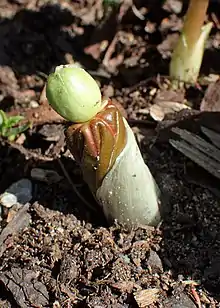American Mayapple
The American Mayapple is a herbaceous perennial plant, native to the eastern part of North America.

The stem grows between 30 and 40 cm tall. The plant produces two growth forms. The one with a single umbrella-like leaf does not produce any flowers or fruit. The plants have a twin leaf (rarely three-leaf) structure, however, a single white flower with a 3-5 cm diameter with six (rarely up to nine) petals, between the two leaves; this matures into a yellow-greenish fruit 2-5 cm long. The plant normally grows in groups in open woodlands. Individual shoots are often connected by systems of thick roots.
Despite the name "mayapple," it is the flower that appears in early May, not the "apple," which appears later in the summer. The American Mayapple is also called the Devil's apple, hogapple, Indian apple, umbrella plant, wild lemon, wild mandrake, and American mandrake.
According to Brian Fondren, the mayapple had been used for a variety of medicinal purposes, originally by Native Americans and later by other settlers.
Toxicity
All the parts of the plant, except the fruit, are poisonous. The plant can kill a person in 24 hours. Even the fruit, which is not dangerously poisonous, can cause red or yellow diarrhea.